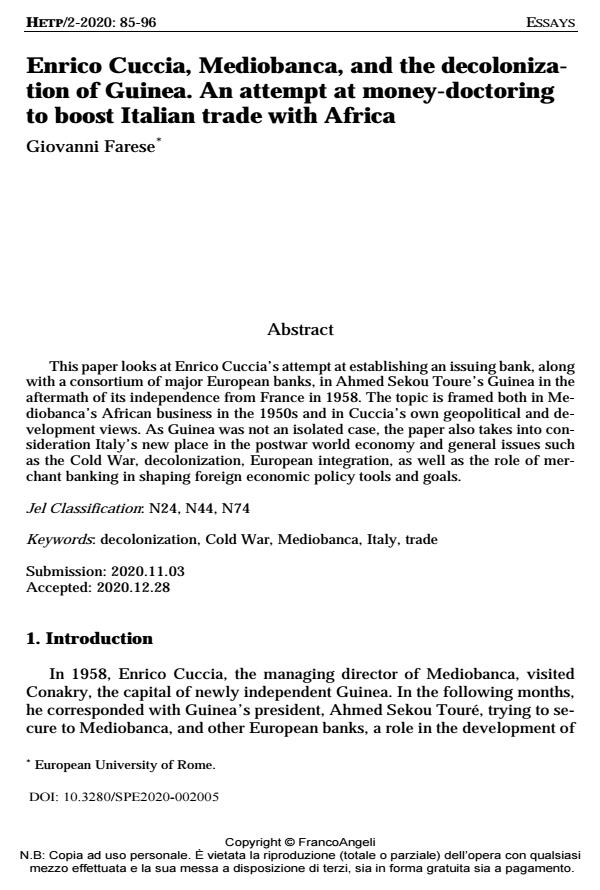Enrico Cuccia, Mediobanca, and the decolonization of Guinea. An attempt at money-doctoring to boost Italian trade with Africa
Journal title HISTORY OF ECONOMIC THOUGHT AND POLICY
Author/s Giovanni Farese
Publishing Year 2021 Issue 2020/2 Language Italian
Pages 12 P. 85-96 File size 79 KB
DOI 10.3280/SPE2020-002005
DOI is like a bar code for intellectual property: to have more infomation
click here
Below, you can see the article first page
If you want to buy this article in PDF format, you can do it, following the instructions to buy download credits

FrancoAngeli is member of Publishers International Linking Association, Inc (PILA), a not-for-profit association which run the CrossRef service enabling links to and from online scholarly content.
This paper looks at Enrico Cuccia’s attempt at establishing an issuing bank, along with a consortium of major European banks, in Ahmed Sekou Toure’s Guinea in the aftermath of its independence from France in 1958. The topic is framed both in Mediobanca’s African business in the 1950s and in Cuccia’s own geopolitical and development views. As Guinea was not an isolated case, the paper also takes into consideration Italy’s new place in the postwar world economy and general issues such as the Cold War, decolonization, European integration, as well as the role of merchant banking in shaping foreign economic policy tools and goals.
Keywords: Decolonization, Cold War, Mediobanca, Italy, trade
Jel codes: N24, N44, N74
- Battilossi S. (1996). L’Italia nel sistema economico internazionale. Il management dell’integrazione: industria, finanza, istituzioni, 1945-1955. Milano, FrancoAngeli.
- Battilossi S., Cassis Y. (eds.) (2002). European Banks and the American Challenge. Competition and Collaboration in International Banking under Bretton Woods. Oxford, Oxford University Press.
- Bussière E., Dumoulin M., Willaert E. (2008). The Bank of the European Union, The EIB, 1958-2008. Luxembourg, European Investment Bank.
- Bohème O. (2007), Monetary Affairs in the Heart of Africa. The National Bank of Belgium and Finance in Congo, 1945-1974. The Journal of European Economic History, 1: 13-45.
- Brambilla C. (2013). La sfida internazionale della Comit. Bologna, il Mulino.
- Calandri E. (2009). Il primato sfuggente: l’Europa e l’intervento per lo sviluppo (1957-2007). Milano, FrancoAngeli.
- Carli G. (1993). Cinquant’anni di vita italiana. Rome-Bari, Laterza.
- Conte L., Piluso G. (2012). Il finanziamento dell’IRI e i rapporti con il sistema bancario (1948-1972). In Amatori F. (ed.). Storia dell’IRI. 2. Il miracolo economico e il ruolo dell’IRI. Rome-Bari, Laterza, 463-522.
- De Cecco M., Ferri G. (1996). Le banche d’affari in Italia. Bologna, il Mulino.
- Farese G. (2017). Giorgio Ceriani Sebregondi e l’ingresso dell’Italia nella cultura internazionale dello sviluppo. Soveria Mannelli, Rubbettino.
- Farese G. (2020). Mediobanca e le relazioni economiche internazionali dell’Italia. Atlantismo, integrazione europea e sviluppo dell’Africa. Milano, Mediobanca.
- Flandreau M. (ed.) (2003). Money Doctors: The Experience of Financial Advising, 1850-2000. New York, Routledge.
- Garavini G. (2012). After Empires. European Integration, Decolonization, and the Challenge from Global South, 1957-1986. Oxford, Oxford University Press.
- Graziani A. (1998). Lo sviluppo dell’economia italiana. Dalla ricostruzione alla moneta europea. Torino, Bollati Boringhieri.
- Grilli E. (1993). The European Community and the Developing Countries. Cambridge, Cambridge University Press.
- Harper J.L. (1987). L’America e la ricostruzione dell’Italia. Bologna, il Mulino.
- Helleiner E. (2009). Central Bankers as Good Neighbours: US Money Doctors in Latin America in the 1940s. Financial History Review, 16(1): 5-25.
- Helleiner E. (2016). The Forgotten Foundations of Bretton Woods. International Development and the Making of Post-war International Order. Ithaca, Cornell University Press.
- Hopkins A.G. (2019). An Economic History of West Africa. Abingdon: Routledge.
- Krotz U., Patel K.K., Romero F. (2020). Europe’s Cold War Relations. The EC towards a Global Role. London, Bloomsbury.
- La Malfa G. (2014). Cuccia e il segreto di Mediobanca. Milano, Feltrinelli.
- Lorenzini S. (2019). Development. A Cold War History. Princeton, Princeton University Press.
- Mammarella G., Cacace P. (2006). La politica estera dell’Italia. Dallo Stato unitario ai giorni nostri. Rome-Bari, Laterza.
- Martelli M., Procino M. (eds.) (2007). Enrico Cuccia in Africa Orientale (1936-1937). Milano, FrancoAngeli.
- Morone A.M. (2011). L’ultima colonia. Come l’Italia è tornata in Africa, 1950-1960. Rome-Bari, Laterza.
- Piluso G. (2005). Mediobanca. Tra regole e mercato. Milano, Egea.
- Sbrana F. (2006). Portare l’Italia nel mondo. L’IMI e il credito all’esportazione. Bologna, il Mulino.
- Schenk C. (1997). Monetary Institutions in Newly Independent Countries: the experience of Malaya, Ghana and Nigeria in the 1950s. Financial History Review, 4: 181-198.
- Segreto L. (2008). Il caso Mediobanca. In. A. Cova, S. La Francesca (eds). Storia d’Italia. Annali, 23. La Banca. Torino, Einaudi, 785-823.
- Unger C. (2018). Postwar Development Aid: Defined by Decolonization, the Cold War, and European Integration. In Macekura S., Manela E. (eds.). The Development Century: A Global History. Cambridge, Cambridge University Press, 240-260.
Giovanni Farese, Enrico Cuccia, Mediobanca, and the decolonization of Guinea. An attempt at money-doctoring to boost Italian trade with Africa in "HISTORY OF ECONOMIC THOUGHT AND POLICY" 2/2020, pp 85-96, DOI: 10.3280/SPE2020-002005